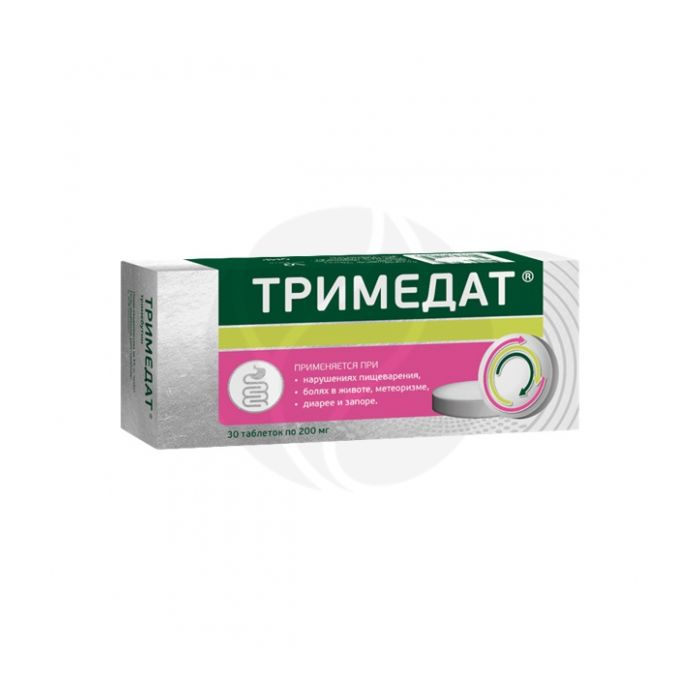Trimedat tablets 200mg, No. 30
Expiration Date: 05/2027
Russian Pharmacy name:
Тримедат таблетки 200мг, №30
Motor disorders in functional diseases of the gastrointestinal tract, gastroesophageal reflux disease, dyspeptic disorders in gastroduodenal diseases (abdominal pain, indigestion, nausea, vomiting), irritable bowel syndrome (functional disease of the gastrointestinal tract, manifested, in particular, by pain and colic in the abdomen, intestinal cramps, flatulence, diarrhea and / or constipation).
Postoperative paralytic intestinal obstruction, preparation for X-ray and endoscopic studies of the gastrointestinal tract.
Application in children: dyspeptic disorders associated with impaired gastrointestinal motility.
Inside.
Adults and children from 12 years old: 100-200 mg 3 times a day.
Children 3-5 years old: 25 mg 3 times a day.
Children 5-12 years old: 50 mg 3 times a day.
One tablet contains:
Active ingredient: trimebutin maleate 200 mg;
Excipients: lactose, colloidal silicon dioxide, talc, corn starch, magnesium stearate.
Hypersensitivity to the components that make up the drug. Children under 3 years old - for this dosage form.
It is not recommended to use the drug in the first trimester of pregnancy. It is not recommended to prescribe Trimedat during lactation, due to the lack of reliable clinical data confirming the safety of the drug during this period.
In experimental studies, no data were found on the teratogenicity and embryotoxicity of the drug.
Trade name: Trimedat
International non-proprietary name:
trimebutin
Dosage form:
pills
Composition
One tablet contains:
Active substance: trimebutin maleate 200 mg;
Excipients: lactose, colloidal silicon dioxide, talc, corn starch, magnesium stearate.
Description
Tablets of white color, flat-cylindrical with an embossed symbol on one side, representing two letters TM, above and below which there are three triangles in a line and two intersecting marks on the other side of the tablet (for a dosage of 100 mg).
The tablets are white, round, biconvex, with an embossed symbol on one side in the form of two drop-shaped elements and a line on the other side (for a dosage of 200 mg).
Pharmacotherapeutic group:
antispasmodic
ATX code: A03AA05
Pharmacological properties
Pharmacodynamics
Trimebutin, acting on the enkephalinergic system of the intestine, is a regulator of its peristalsis. Possessing an affinity for receptors of excitation and suppression, it has a stimulating effect in hypokinetic states of intestinal smooth muscles and antispasmodic in hyperkinetic states. The drug acts along the entire length of the gastrointestinal tract, reduces the pressure of the esophageal sphincter, promotes gastric emptying and increased intestinal motility, and also promotes the response of the smooth muscles of the colon to food stimuli. Trimebutin restores the normal physiological activity of the intestinal musculature in various diseases of the gastrointestinal tract associated with motility disorders.
Pharmacokinetics
After oral administration, trimebutin is rapidly absorbed from the gastrointestinal tract, the maximum plasma concentration (Cmax) is reached after 1-2 hours. Bioavailability is 4-6%. Volume of distribution (Vd) - 88 liters. The degree of binding to plasma proteins is low - about 5%. Trimebutin slightly crosses the placental barrier.
Metabolism and excretion
Trimebutin is biotransformed in the liver and excreted in the urine mainly in the form of metabolites (approximately 70% during the first 24 hours). The half-life (T1 / 2) is about 12 hours.
Indications for use
Motor disorders in functional diseases of the gastrointestinal tract, gastroesophageal reflux disease, dyspeptic disorders in gastroduodenal diseases (abdominal pain, indigestion, nausea, vomiting), irritable bowel syndrome (functional disease of the gastrointestinal tract, manifested, in particular, by pain and colic in the abdomen, intestinal cramps, flatulence, diarrhea and / or constipation).
Postoperative paralytic intestinal obstruction, preparation for X-ray and endoscopic studies of the gastrointestinal tract.
Application in children: dyspeptic disorders associated with impaired gastrointestinal motility.
Contraindications
Hypersensitivity to the components that make up the drug. Children under 3 years old - for this dosage form.
Application during pregnancy and lactation
It is not recommended to use the drug in the first trimester of pregnancy. It is not recommended to prescribe Trimedat during lactation, due to the lack of reliable clinical data confirming the safety of the drug during this period.
In experimental studies, no data were found on the teratogenicity and embryotoxicity of the drug.
Dosing and Administration
Inside.
Adults and children from 12 years old: 100-200 mg 3 times a day.
Children 3-5 years old: 25 mg 3 times a day.
Children 5-12 years old: 50 mg 3 times a day.
Side effect
Rarely: skin reactions
Overdose
To date, no cases of overdose of the drug Trimedat have been reported.
Interaction with other drugs
Drug interaction of the drug Trimedat is not described.
Release form
Tablets 100 mg, 200 mg. 10 tablets in a blister made of polyvinyl chloride film and lacquered aluminum foil. 1, 2 or 3 blister packs, together with instructions for use, are placed in a box made of cardboard box.
Storage conditions
At a temperature not exceeding 25 ? —. Keep out of the reach of children.
Shelf life is
3 years.
Do not use after the expiration date.
Terms of dispensing from pharmacies:
without recipe.

